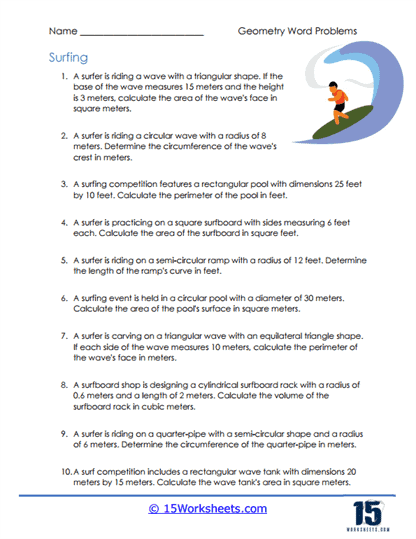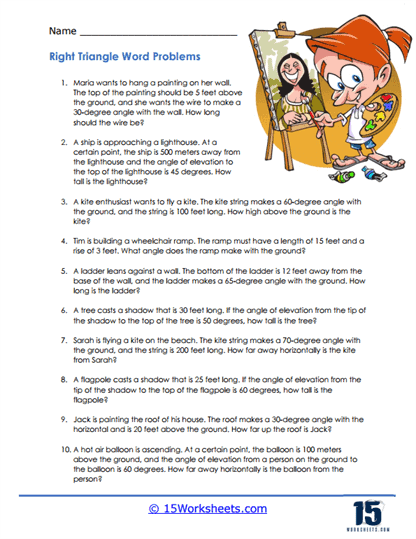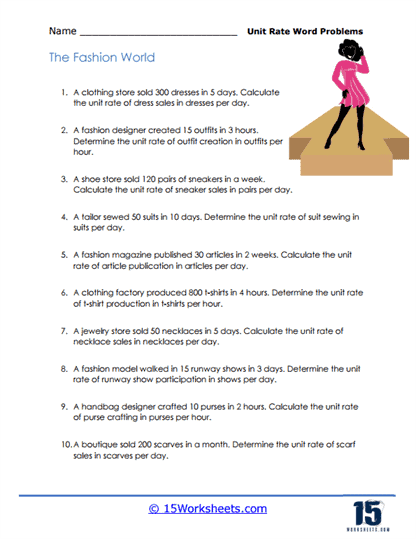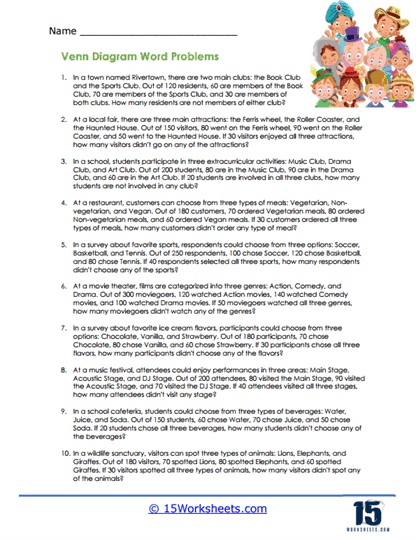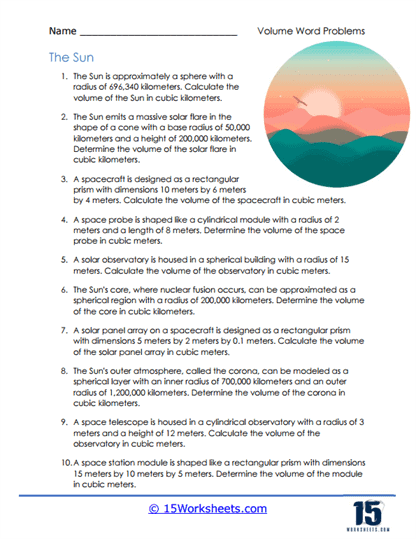Word Problems Worksheets
About These 15 Worksheets
Absolute value represents the distance of a number from zero on the number line and is often used to express the magnitude or size of a quantity without regard to its sign (positive or negative). These worksheets contain exercises and problems that require students to apply the concept of absolute value to real-life situations.
Addition is a fundamental arithmetic operation, and these worksheets teach students how to translate written problems into mathematical equations and solve them using addition. These skills are not only crucial for success in mathematics but also for solving practical problems and making informed decisions in daily life.
These worksheets contain a variety of exercises and problems that require students to translate real-life situations or scenarios into algebraic equations, solve for unknown variables, and apply algebraic reasoning to find solutions. The is to learn how to apply algebraic concepts to solve real-world problems.
These worksheets will teach students how to use decimal notation and operations to solve problems involving quantities, measurements, money, and other real-world applications. They can help students bridge the gap between abstract decimal concepts and practical problem-solving skills.
These worksheets prepare students to apply division to various situations, making them better equipped to solve real-world problems that involve sharing, distribution, rates, and resource allocation. Students will learn how to read and interpret word problems, extracting relevant information and identifying key elements, such as the dividend, divisor, and quotient.
These worksheets help students bridge the gap between precise calculations and practical decision-making. They prepare students to make informed estimations in various situations, allowing them to quickly assess the magnitude of quantities, assess reasonableness, and make efficient and accurate decisions.
These worksheets prepare students to use fractions effectively in various situations, allowing them to represent and manipulate parts of a whole, compare quantities, and make informed decisions based on fractions.
The nature of the questions can vary widely. They might involve areas, perimeters, volumes, angles, lengths, distances, coordinates, or other geometric measurements and concepts. The problems might relate to everyday experiences, such as determining the area of a room, or more abstract scenarios, such as proving a particular geometric theorem.
Proficiency in solving measurement word problems is valuable for various fields and industries where measurements are essential, such as science, engineering, construction, cooking, and more.
These worksheets teach students how to use multiplication to calculate quantities, find the total of repeated groups, determine rates, and solve various practical problems. These types of problems help students see the relevance of multiplication in everyday life.
Working with these types of problems is essential for financial literacy, understanding data representation, and making informed decisions in various fields, including finance, business, statistics, and data analysis. They have students calculate discounts, analyze data, determine proportions, and solve problems involving percentages accurately and efficiently.
Proportional Relationship Word Problems
These worksheets have a variety of exercises and problems that require students to apply their understanding of proportions and ratios to real-life scenarios and mathematical contexts. Students practice recognizing situations where quantities are in proportion to each other, which means they maintain a constant ratio.
Ratio and Proportions Word Problems
These types of problems teach students how to work with ratios, set up and solve proportion equations, and use proportionality to make comparisons and solve various practical problems. Students learn to identify relationships between quantities and how to express these relationships using ratios and proportions.
Proficiency in solving rounding word problems is valuable for estimating quantities, making quick assessments, and solving problems in contexts where precise values may not be necessary. These worksheets prepare students to apply rounding skills to real-world scenarios, allowing them to approximate quantities, make informed decisions, and solve problems efficiently and accurately.
These worksheets prepare students to apply subtraction skills to real-world scenarios, allowing them to find differences, make assessments, and solve problems involving subtraction accurately and efficiently. Students learn how to read and interpret word problems, extracting relevant information and identifying key elements that involve subtraction, such as the numbers to be subtracted and the context of the problem.
These worksheets prepare students to apply time skills to real-world scenarios, allowing them to manage time effectively, schedule events, and solve problems involving time accurately and efficiently. Students learn the importance of precision in time calculations, including considering time zones, daylight saving time, and rounding time values appropriately.
Unit rate word problems focus on situations where different quantities are compared to one unit of another quantity. A unit rate describes how many units of the first type of quantity correspond to one unit of the second type of quantity. In simpler terms, it’s often the “per” in problems, such as “miles per hour” or “dollars per item.”
These are types of problems involve determining the amount of space that an object occupies, usually presented in a textual format. These problems typically require knowledge of geometric formulas and concepts related to three-dimensional shapes such as cylinders, spheres, cones, cubes, and rectangular prisms.
About Our Word Problem Worksheets
You know, when you’re learning math, it isn’t just about crunching numbers or memorizing formulas. Math is like a secret language that helps us solve puzzles, understand the world around us, and even make cool things happen. One way that you can learn to speak this secret language better is by using Math Word Problems Worksheets.
Think of these worksheets as adventure stories, but instead of just reading them, you become the hero who solves the mystery. Each story, or problem, is a small puzzle waiting for you to figure out. But the clues aren’t hidden in a secret map or a coded message, they are hidden in the words of the story. That’s why they are called “word problems.” The words give you the information you need to solve the problem.
Let’s take an example. Imagine a word problem that says, “Amy has 5 apples. She eats 2 and gives 1 to her friend. How many apples does Amy have now?” It’s like a story, right? And your job is to figure out how many apples Amy has at the end of the story.
You will come across many problems like this, each one a little different, each one a new puzzle to solve. Sometimes the problems involve addition or subtraction, like the apple problem. Other times they might involve multiplication, division, fractions, or other math concepts you’re learning.
The amazing thing about these worksheets is that they don’t just help you practice math. They also help you become a better problem solver, like a detective. You learn to read carefully, pick out the important information, and figure out what to do with it. This is a skill that’s not just important for math, but for lots of things in life.
One more cool thing about these worksheets is they often relate to real-life situations. Like, figuring out how many apples Amy has after she eats some and gives some away? That could happen in real life! Or figuring out how many miles you can travel if you know the speed and the time? That’s useful too! These aren’t just abstract puzzles; they’re like training exercises for real-life problem solving.
What Are Math Word Problems?
Math word problems are mathematical exercises presented in the form of a narrative or story. They require understanding the story, translating it into a mathematical problem, and then solving that problem. Word problems help to demonstrate the practical application of abstract mathematical concepts in real-life situations. They require not just mathematical knowledge, but also reading comprehension, logic, and problem-solving skills.
How to Solve Them
Solving math word problems often involves several steps, which are generally as follows:
Read the problem carefully – Understand what the problem is asking. You might need to read the problem several times.
Identify the information given – Highlight or note down the numbers and facts you have.
Identify what you need to find – Understand what the question is asking you to find or solve.
Choose the Math Operation(s) That Are Involved
Determine which mathematical operations (addition, subtraction, multiplication, division, etc.) you need to use to solve the problem. Identifying the correct mathematical operation to use in a word problem can sometimes be challenging. However, certain keywords or phrases can guide you toward the right operation. Here are some common words and phrases associated with the four basic mathematical operations:
- Addition: Add, plus, increase, more, combined, total, sum, together, gain, additional, in all
- Subtraction: Subtract, minus, less, difference, fewer, take away, decrease, remaining, left, lost
- Multiplication: Multiply, times, product, of, double, triple, each, per, every
- Division: Divide, quotient, per, each, evenly, out of, ratio, fraction
Remember, these are not hard rules. The context of the problem is very important, and sometimes problems may require more than one operation. Also, as you progress to higher level mathematics, the operations become more complex, and the same keywords may be used in different contexts. Always read the problem carefully, understand the situation it is describing, and determine the operation based on the context as well as the keywords.
Write an equation – Translate the word problem into a mathematical equation.
Solve the equation – Use your math skills to solve the equation.
Check your work – Make sure your answer makes sense in the context of the problem. You can also substitute your answer back into the equation to ensure it works.
Write the answer in a complete sentence – Especially in a school setting, it’s important to present your answer clearly and in context of the problem.
For example, if we take the problem I mentioned earlier:
“Sarah has 5 apples. She gives 2 apples to her friend. How many apples does Sarah have left?”
Read the problem carefully – You understand Sarah initially had some apples, she gives away a few, and you need to find out how many she has now.
Identify the information given – Sarah has 5 apples initially and she gives away 2 apples.
Identify what you need to find – The number of apples Sarah has left.
Choose the operation(s) – This problem requires subtraction. This is due to the of the word “left” which means something was taken away from the original value.
Write an equation: 5 (initial apples) – 2 (apples given away) = ? (apples left).
Solve the equation: 5 – 2 = 3.
Check your work: Does it make sense that Sarah would have 3 apples left after giving 2 away from her initial 5? Yes, it does.
Write the answer in a complete sentence – Sarah has 3 apples left.








